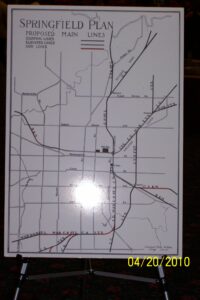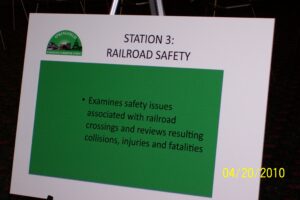If this country paid the real price for coal instead of socializing the costs (ie. transferring the cost to the general public) it would be too expensive to burn. If the Coal Industry had to pay the real cost of drilling the holes (tax free zones), making the holes safe (complying with regulations instead of being lightly fined), freeing the coal of its nasty properties (passed onto the consumers of coal), safely disposing of those associated wastes (see articles below) and pay part of the costs of the effects of their uses on the environment (passed on to the end users and consumers) then we would never even think about using that stuff. But they get passes on all of that and they put the public at risk. Oh and they want to put in the levies too.
What the activists say:
http://www.sourcewatch.org/index.php?title=Illinois_and_coal
Introduction
Coal production is a major part of the Illinois economy. In 2004, the state produced over 31 million short tons of coal worth an estimated $819 million dollars, which ranked it 9th in the nation in coal production.[1] Coal deposits underly 37,000 square miles of Illinois, about two thirds the entire state. Recoverable coal reserves are estimated to total 30 billion tons, accounting for almost one-eighth of the nation’s total coal reserves and one-fourth of bituminous coal reserves.[2] In comparison to western coal, Illinois coal is high in sulfur, and even when cleaned the sulfur content averages 2 to 3 percent by weight.[3]
The state consumed over 54 million short tons of coal for electrical power in 2004,[1] producing approximately 48 percent of the electricity generated in Illinois. The state’s average retail price of electricity is 7.07 cents per kilowatt hour, the 20th lowest rate in the nation[4] In 2003, Illinois emitted 230 million metric tons of carbon dioxide emissions, ranking it 7th in the nation overall.[5]
Citizen activism
In a major survey article for the Illinois Times on the coal fight in the state, Peter Downs wrote:[6]
-
- All across Illinois — at town-hall meetings, in federal courts, in the Capitol — battles are raging over coal power, the outcome of which could very well determine the role of the black rock in the nation’s energy future.
- Illinois is at the heart of the national debate because in no other state have coal interests pushed for more new investment — with critical support from the state’s governmental leaders.
- According to the U.S. Department of Energy’s National Electric Technology Laboratory, a year ago Illinois had proposals for more new coal-based electric-power plants — 16 — than any other state, and the plants proposed for Illinois would have the capacity to generate twice as much electricity as even the most ambitious proposals for any other state.
- According to the report, “Coal’s Resurgence in Electric Power Generation,” which was issued on May 1, 2007, more than 10 percent of all new generating capacity from coal-based power plants would be built in Illinois. With 22 coal-burning power plants already providing 49 percent of Illinois’ electricity, the state was unusually reliant on coal for its energy needs. Keep in mind that in the previous seven years, only 10 coal-based power plants had been constructed in all of the United States.
- A year after the Department of Energy’s announcement, the Sierra Club has claimed “victory” against all but five of the previously proposed plants, but those remaining five are among the biggest of the proposed projects and they would add substantially to the state’s capacity to generate electricity and air pollution.
- “We started our coal campaign in Illinois because more [coal-based power] plants were proposed in Illinois than anywhere else,” says Becki Clayborn, regional representative of the Sierra Club.
:}
What the Newspaper reports:
Activists raise concerns about coal mine slurry injection in Illinois
Coal mining companies are supposed to clean up after themselves, and the government is supposed to ensure groundwater is pure.
But environmental activists fear that mining companies in central and southern Illinois may poison aquifers by injecting potentially dangerous pollutants into the ground with inadequate review by regulators and no notice to the public.
The state has already allowed the practice at the Crown Mine No. 3 near Girard, and the owner of the Shay No. 1 Mine near Carlinville, which closed in 2007 but reopened last year, has applied for permission. Activists fear this is just the beginning as coal companies develop new mines and restart old ones.
The waste is a byproduct of washing coal. The slurry that results can contain arsenic, heavy metals and other pollutants. The website of the state Office of Mines and Minerals says the material “can be potentially acid-forming and/or toxic.”
The danger is serious enough that the practice of injecting coal slurry into the ground has been curtailed in West Virginia, where more than 100 lawsuits are pending by residents who blame coal companies for poisoning wells.
:}
http://www.chicagotribune.com/topic/sns-bc-il–levees-coalash,0,5870784.story
Environmentalists question Army Corps of Engineers plan to use coal ash as levee fix
ST. LOUIS (AP) — A federal plan to use ash waste from coal-fired power plants to shore up some Mississippi River levees drew objections Thursday from environmentalists who are worried that toxins in the ash might seep into the river and public water systems it serves.
The Sierra Club and other nature groups lined up against the Army Corps of Engineers’ plan, worrying during a public hearing that the use of coal or fly ash questionably could extend later to levees along other inland rivers and perpetuate coal burning, widely believed to contribute to global warming.
“If this should turn out to be toxic (after it’s been injected into a levee’s weak spots), how do we get it back out?” Tom Ball, a member of the Sierra Club and Missouri Stream Team, pressed during the 90-minute hearing that drew about 50 people, including electric utility representatives
“This fly ash is hazardous waste, regardless of what you call it,” added Catherine Edmiston, an environmentalist heading an Illinois group opposing longwall mining. “I am against putting it against a major river. I think we need to think about this.”
Corps officials called the injection of a slurry of water, coal ash and lime into 25 miles of slide-prone levees in 200-mile stretch of the river from Alton, Ill., near St. Louis to southern Illinois’ tip the cheapest, longest-lasting fix among several options it weighed.
Yet the corps pledged not to move hastily, calling any decision months away and pressing that the search for the cheapest fix for taxpayers won’t trump public safety. For now, the corps says, the ash-slurry plan appears be
:}
http://www.thetelegraph.com/articles/ash-42552-corps-louis.html
Army Corps considering coal ash to fix levees
ST. LOUIS (AP) – The Army Corps of Engineers wants to use ash cast off from coal-fired electrical generation to shore up dozens of miles of Mississippi River levees, drawing fire from environmentalists worried that heavy metals from the filler might make their way into the river.
The corps announced the plan last month, touting the injection of a slurry of water, coal ash and lime into 25 miles of slide-prone levees in 200-mile stretch of the river from Alton, Ill., near St. Louis to tiny Gale on southern Illinois’ tip as the cheapest, longest-lasting fix among several options it weighed.
A public hearing on the matter, scheduled Thursday in St. Louis, is certain to elicit questions from environmentalists who consider the use of coal ash – also known as fly ash – a bad idea despite corps assurances that it has been used trouble-free on levees near Memphis for more than a decade.
:}
More Tomorrow
:}















 The World Petroleum Congress takes place June 29 through July 3 at the IFEMA-Feria de Madrid convention center. The sprawling complex is in one of Madrid’s new business areas, just minutes by car or underground from the city’s Barajas International Airport. (Chevron Photo)
The World Petroleum Congress takes place June 29 through July 3 at the IFEMA-Feria de Madrid convention center. The sprawling complex is in one of Madrid’s new business areas, just minutes by car or underground from the city’s Barajas International Airport. (Chevron Photo)














